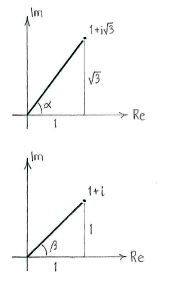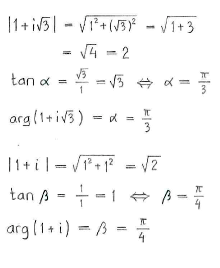Lösung 3.3:1d
Aus Online Mathematik Brückenkurs 2
K (Solution 3.3:1d moved to Lösung 3.3:1d: Robot: moved page) |
|||
| Zeile 1: | Zeile 1: | ||
| - | + | Wir bringen zuerst | |
| - | <math>1+i\sqrt{3}</math> | + | <math>1+i\sqrt{3}</math> und <math>\text{1}+i</math> auf Polarform, und rechnen weiterhin in Polarform. |
<center>[[Image:3_3_1_d.gif]] [[Image:3_3_1_d_text.gif]]</center> | <center>[[Image:3_3_1_d.gif]] [[Image:3_3_1_d_text.gif]]</center> | ||
| - | + | Wir erhalten | |
{{Abgesetzte Formel||<math>\begin{align} | {{Abgesetzte Formel||<math>\begin{align} | ||
| Zeile 11: | Zeile 11: | ||
\end{align}</math>}} | \end{align}</math>}} | ||
| - | + | und also | |
{{Abgesetzte Formel||<math>\begin{align} | {{Abgesetzte Formel||<math>\begin{align} | ||
| Zeile 20: | Zeile 20: | ||
\end{align}</math>}} | \end{align}</math>}} | ||
| - | + | Durch den Moivreschen Satz erhalten wir schließlich | |
{{Abgesetzte Formel||<math>\begin{align} | {{Abgesetzte Formel||<math>\begin{align} | ||
Version vom 14:47, 18. Mai 2009
Wir bringen zuerst \displaystyle 1+i\sqrt{3} und \displaystyle \text{1}+i auf Polarform, und rechnen weiterhin in Polarform.


Wir erhalten
| \displaystyle \begin{align}
1+i\sqrt{3} &= 2\Bigl(\cos\frac{\pi}{3} + i\sin\frac{\pi}{3}\Bigr)\\[5pt] 1+i &= \sqrt{2}\Bigl(\cos\frac{\pi}{4} + i\sin\frac{\pi}{4}\Bigr) \end{align} |
und also
| \displaystyle \begin{align}
\frac{1+i\sqrt{3}}{1+i} &= \frac{2\Bigl(\cos\dfrac{\pi}{3} + i\sin\dfrac{\pi}{3}\Bigr)}{\sqrt{2}\Bigl(\cos\dfrac{\pi}{4} + i\sin\dfrac{\pi}{4}\Bigr)}\\[5pt] &= \frac{2}{\sqrt{2}}\Bigl(\cos\Bigl(\frac{\pi}{3}-\frac{\pi}{4}\Bigr) + i\sin\Bigl(\frac{\pi}{3}-\frac{\pi}{4}\Bigr)\Bigr)\\[5pt] &= \sqrt{2}\Bigl(\cos\frac{\pi}{12} + i\sin\frac{\pi}{12}\Bigr)\,\textrm{.} \end{align} |
Durch den Moivreschen Satz erhalten wir schließlich
| \displaystyle \begin{align}
\Bigl(\frac{1+i\sqrt{3}}{1+i}\Bigr)^{12} &= \bigl(\sqrt{2}\,\bigr)^{12}\Bigl(\cos\Bigl(12\cdot\frac{\pi}{12}\Bigr) + i\sin\Bigl(12\cdot\frac{\pi}{12}\Bigr)\Bigr)\\[5pt] &= 2^{(1/2)\cdot 12}(\cos\pi + i\sin\pi)\\[5pt] &= 2^6\cdot (-1+i\cdot 0)\\[5pt] &= -64\,\textrm{.} \end{align} |
